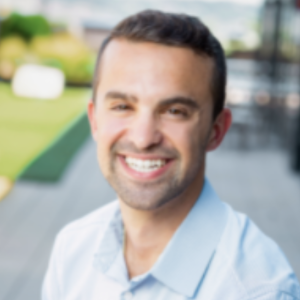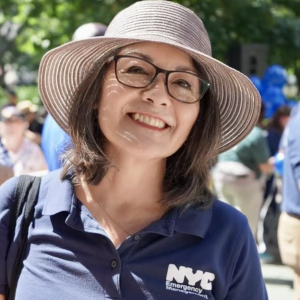WORKING GROUP 3: EVERYONE HAS A ROLE TO PLAY
Focusing on shared ownership among government, non-profit, public, and private sectors to address the challenge of heavy rainfall, this working group sought to answer the following questions:
- What tools, resources, and knowledge do New Yorkers need to become rainproof?
- How do we activate existing resources to create, adopt, and own initiatives that will transform New York from a concrete jungle into a sponge?
- How do we encourage civic engagement and collaboration among non-profit, private, and public sectors to address increasing rainfall?
To this end, the group cataloged existing programs, resources, and stakeholders; and identified risks and limitations of a collaborative, city-wide effort to address increased heavy rainfall.
Twenty-nine individuals representing all five boroughs and affiliated with public, non-profit and private organizations contributed to the effort. Under the leadership of Hayley Elszasz of the Mayor’s Office of Climate & Environmental Justice (MOCEJ) and Tonya Gayle of Green City Force, participants explored paths for increasing involvement in mitigating extreme rain across all sectors. View WG3 members here>>
THE CHALLENGE
New York is a diverse and global city by all standards: age, ability, race, religion, ethnicity, and even biodiversity. NYC residents speak over 200 languages, and across the five boroughs, reside anywhere from 0-401 feet above sea level. These variations impact NYC residents’ everyday experience and access to resources: this must be considered when designing equitable climate change resiliency strategies.
- Existing tools and resources for extreme rain mitigation, preparedness, response and recovery are not widely accessible due to limited language, financial, digital literacy, or technology access.
- Existing tools and resources for mitigation and preparedness are focused on large businesses, real-estate companies, and homeowners; there is a dearth of resources geared toward NYC renters.
- The existing design of New York’s cityscape makes it difficult for New Yorkers to imagine and advocate for public stormwater and/or green and blue infrastructure projects.
- Existing community engagement, greening, and public health education projects do not yet incorporate information and tools to address stormwater flooding.
- The decentralization of existing resources to learn about, mitigate, respond and recover from stormwater flooding creates a critical accessibility barrier.
Recommendations
The below recommendations reflect inputs from working group members, as well as feedback captured during public engagement events. The recommendations are designed to bolster existing efforts and improve communications around extreme rain preparedness and safety. The existing and suggested resources required to implement each recommendation has been categorized by when they are needed (before, during or after a storm) and what the address (health, home, community/city).
Phase: Before⛅ During☔After 🌅. Scale: Health ❤️, Home 🏡 , Community/City 🏙️
RECOMMENDATION #1:
Make Rainproof a part of regular community engagement to increase New Yorkers’ ability and sense of urgency to prepare for extreme rain.
⛅ ☔ ❤️ 🏡
PRIORITY LEVEL: HIGH
SOLUTION:
Incorporate Rainproof into existing programs, events, and resources, instead of creating new programs/events, i.e. “Do what you do, but do it Rainproof.”
IMPLEMENTATION:
- Leverage existing public programs such as DEP’s hydra barrier distribution program with Borough Presidents, NYCEM’s Strengthening Communities Program, DOHMH’s “Be a Buddy” program, CERT Volunteer program; DOHMH Community Health Workers; SRIJB* Community Flood Fellows; NYC Days of Action.
- Engage existing platforms for civic engagement, including town halls, community boards, civic associations, “friends of” parks groups, etc.
- Partner with public and non-profit agencies that have existing infrastructure to train and manage workforce for outreach, flier distribution, and volunteer coordination at events. For example: NYC Civic Corps Fellows, NYC Service Summer Employment, Rain Coalition, Green City Force & The HOPE Program.
RECOMMENDATION #2:
Create a public outreach campaign that prioritizes information and resource allocation to populations affected by extreme rain; diversify materials to address accessibility gaps.
⛅ ☔ 🌅 ❤️ 🏡
PRIORITY LEVEL: HIGH
SOLUTION:
Create a Rainproof toolkit for residents of New York that outlines risks, tools, and resources for all residents; is available digitally and through print; is inclusive of renters; and prioritizes communities who are most vulnerable to stormwater flooding.
IMPLEMENTATION:
- Develop a digestible communication tool to link resources to the before, during, after categories for health, home, and community/city.
- Create opportunities for New Yorkers to physically engage with stormwater infrastructure, such as bluebelts, catch basins, or rain gardens through employment opportunities, volunteerism (i.e. Super Steward, `Citizen Pruner, Master Composter), and recreation
- Expand access to existing resources through language translation and print media (i.e. no internet or apps). Examples of existing resources that address accessibility barriers: Rainfall Ready, Stormwater flood maps, FloodhelpNY.org, Notify NYC, WAIT!
- Develop a guide for multifamily property owners and managers to identify flood-threat, incorporate flood-proofing measures, and inform tenants about stormwater flooding risks, resources, and emergency communication systems.
- Develop a guide for renters on how to be prepared for extreme rainfall. Although limited, renters can take actions such as enrolling in NotifyNYC, elevating important belongings before a storm, forming relationships with neighbors to have a safe space to be during the event, understanding the risk of their building and area, purchasing rental insurance, understanding community organizations/resources available in their neighborhood, cleaning catch basins near their apartment, and calling 311 to report on extreme rainfall.
RECOMMENDATION #3:
Invest in and equip community leaders with tools to interpret rain forecasts, understand stormwater risks, and communicate risks and resources to their constituents.
⛅ ❤️ 🏡
PRIORITY LEVEL: MED
SOLUTION:
Launch a citywide team of paid community Risk Translators who will be trained to interpret rain forecasts, assess stormwater risks engage constituents in the Rainproof Toolkit (see recommendation #2), and advocate for the unique Rainproofing needs of their community.
IMPLEMENTATION:
- Leverage trusted community leaders to engage constituents in the Rainproof toolkit and Rainproof civic engagement events.
- Collaborate with agencies, nonprofits, and community groups to identify potential risk translators and connect with under-represented groups. Potential organizations that could help include, but are not limited to: NYCEM, NYC Service, DOHMH, SRIJB, NY Disaster Interfaith Services (NYDIS)
- Look to existing community advocacy and public agencies’ civic trainings to inform program design. Existing programs that we could learn from include: SRIJB Community Flood Fellows Program, The Sanitation Foundation’s Trash Academy
- Explore corporate funding opportunities for Risk Translators programming
RECOMMENDATION #4:
Encourage collaboration and shared ownership of dealing with extreme rain across city agencies, the private sector, nonprofits, and communities.
⛅ ☔ 🌅 ❤️ 🏡 🏙️
PRIORITY LEVEL: HIGH
SOLUTION:
Launch a diverse, citywide team to centralize Rainproof project management, including policy design, project design, community engagement and resource allocation. Roll out policies that incentivize rainproof design, civic engagement, and long-term solutions to stormwater flooding.
IMPLEMENTATION:
- Require that city agencies include “Rainproof” planning information in any submissions to the Mayor’s Management Report. Consider potential tie-ins with other existing reporting mechanisms as well as new initiatives like Climate Budgeting.
- Incentivize ALL New Yorkers to take ownership of rainproofing their assets for the good of NYC:
- Multi-family affordable housing owners develop business continuity plans, utilizing existing available templates and resources (i.e. Enterprise’s Business Community Tool Kit). Currently the limitation to developing these plans is staff capacity, so providing funding for a staff member’s time, or hiring an intern, or onboarding a consultant to develop this plan would help these plans come to fruition.
- Engagement process with mission-driven multifamily affordable housing owner/operators in areas heavily affected by extreme rainfall will help develop best practices and peer exchange for emergency communication with tenants, building protection during extreme rainfall, business continuity plan development, and more.
- Private companies and financial institutions work through risks and values of stormwater flooding.
- Academic institutions introduce Rainproof into their curricula, classroom, and capstone projects.
- Community-based organizations to educate and engage constituents in Rainproofing NYC.
- City agencies and property owners can collaborate to develop resilience equipment libraries so resources can be shared in areas of high risk (for example back up sump pumps, wet vacs, etc.).
MEET THE members of working group 3
CO-Facilitators

Tonya Gayle
Executive Director, Green City Force

Hayley Elszasz
Climate Science Advisor, Mayor’s Office of Environmental Justice (MOCEJ)
PARTICIPANTS

Abby Jordan
Environmental Fellow/Graduate Student, Columbia University, School of International and Public Affairs (SIPA)
Advisory Board Member, Coney Island Brighton Beach Open Water Swimmers (CIBBOWS)

FRANK BLAncero
Individual

shivali Gowda
Resilience Fellow, Enterprise Community Partners

Andrew Blancero
Individual

Helen Wiley
Disaster Preparedness Program Director, SBP

Hope Sutherland
Project Coordinator, National Center for Disaster Preparedness, Columbia Climate School

RONA TAYLOR
Executive Director, Central x South East Brooklyn CDC

Jill Cornell
New York City Emergency Management (NYCEM)

LOT LOCHER
International Director for Climate, One Architecture

MICHAEL ROBERSON
Director ITP Challenge, Clean Energy Leadership Institute (CELI)
Adjunct Professor, The New School University-Eugene Lang College

Nikki Tourigny
Business Development Manager, The HOPE Program

Pamela Pettyjohn
President and Founder, Coney Island Beautification Project, Inc.

JOHANNA LAWTON
Project Manager, Rebuild by Design

Julia Eiferman
Mayor’s Office of Climate & Environmental Justice (MOCEJ)
Katherin Sibel
Department of Health & Mental Hygiene (DOHMH)
DANIELA SANCU
Department of Small Business Services (SBS)
Adam benditsky
New York City Housing Authority (NYCHA)
Sarah Nielson
New York City Department of Parks & Recreation (PARKS)
Saylor Pochan
Cochair, Surfrider Foundation NYC
Chelsea Cawley
Department of Environmental Protection (DEP)